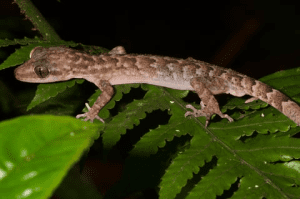TAG: GS 3: ECOLOGY AND ENVIRONMENT
THE CONTEXT: In an exciting development for biodiversity, researchers from India and the United Kingdom have identified six new species of bent-toed geckos, belonging to the genus Cyrtodactylus, from Northeast India.
EXPLANATION:
- This discovery was a collaborative effort involving scientists from the Wildlife Institute of India (WII), the Ashoka Trust for Research in Ecology and Environment (ATREE), and the Natural History Museum, London (NHM).
- These findings underscore the rich and largely unexplored biodiversity of the region, which is known for its varied ecosystems and high levels of species endemism.
Geographical Distribution and Species Discovery
- The new gecko species were discovered across four Northeastern states—Arunachal Pradesh, Nagaland, Manipur, and Mizoram—highlighting the diverse habitats these regions offer.
- Each state contributed two new species to this discovery, with the scientists documenting their presence across different elevations and forest types.
Arunachal Pradesh: Namdapha and Siang Valley Geckos
- In Arunachal Pradesh, the Namdapha bent-toed gecko was found within the Namdapha Tiger Reserve, a well-known biodiversity hotspot.
- This species thrives in lowland evergreen forests, often seen near forest streams, rocks, and dense vegetation.
- Another species was discovered in the Siang Valley, a region celebrated for its unique biodiversity, particularly its forested landscapes that provide a distinct habitat for various species.

Namdapha bent-toed gecko
Nagaland: Kiphire and Barail Hill Bent-Toed Geckos
- Nagaland contributed two species—the Kiphire bent-toed gecko and the Barail Hill bent-toed gecko.
- These species were found in habitats ranging from regenerating jhum land to reserved forests, situated between 740 meters and 1,300 meters above sea level.
- Jhum, a traditional slash-and-burn agricultural practice, has created unique ecological conditions that support the survival and diversification of these geckos.
Mizoram: Ngengpui Bent-Toed Gecko
- In Mizoram, the Ngengpui bent-toed gecko was discovered in the Ngengpui Wildlife Sanctuary, located in the Lawngtlai district.
- This sanctuary, one of the easternmost protected areas in India, is characterized by tropical semi-evergreen to moist evergreen forests.
- These habitats are dominated by species of Dipterocarpus, along with palms, canes, and rattans, providing a rich environment for geckos and other species.
Manipur: Lamdan Bent-Toed Gecko
- The Manipur bent-toed gecko was found near the Lamdan Kabui village, perched on a shrub along a road that connects Leimatak and Charoikhullen.
- This species was observed at an elevation of approximately 1.5 meters, indicating its adaptability to the varied elevations and microhabitats within the region.
Biodiversity and Evolutionary Significance
- These discoveries were the result of extensive surveys conducted from 2018 to 2022 across 22 different locations in Northeast India.
- The identification of six new lineages through morphological and genetic analyses highlights the region’s complex biogeography and the evolutionary processes at play.
- A scientist from Wildlife Institute of India (WII), emphasized that the species diversity south of the Brahmaputra River is particularly high, with each Northeastern state now hosting its own endemic bent-toed gecko species.
- This brings the total number of bent-toed gecko species in the region to around 30, all of which are endemic, underscoring the importance of these areas for herpetological diversity.
Conservation Implications
- The discovery of these gecko species within protected areas such as tiger reserves and wildlife sanctuaries illustrates the untapped biodiversity within these regions.
- However, finding new species in reserved forests and even in abandoned jhum lands points to the ecological significance of these lesser-prioritized areas.
- It highlights the need for conservation strategies that extend beyond the traditionally recognized protected areas, ensuring the protection of habitats that might otherwise be overlooked.

